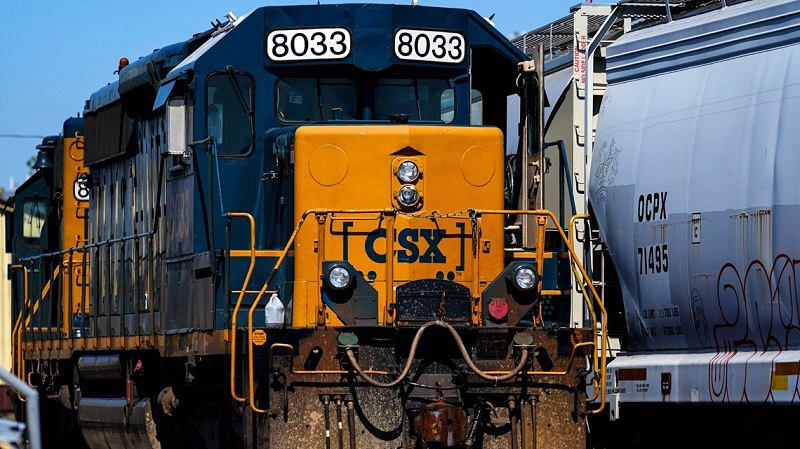Local News
Freight railroads have requested that the courts strike down a new regulation mandating two-person crews on trains

Indianapolis, Indiana – A new rule that would require two-person train crews in most situations has been challenged by four railroads in federal appeals courts, who claim the requirement is arbitrary, capricious, and illegal abuse of power.
Union Pacific, BNSF, and two short-line railroads—the Indiana Railroad and Florida East Coast Railway—filed the same objections to the Federal Railroad Administration’s regulation this week in several appeal courts.
The announcement of the new federal mandate this week marked a turning point in the long-running battle by organized labor to maintain the practice, and it coincided with heightened scrutiny of railroad safety, particularly in the aftermath of the deadly crash in eastern Ohio in February 2023.
The majority of those railroads did not provide further justification for their dislike of the rule right away, but the industry has long been against it, and the trade group Association of American Railroads stated last week that the rule was irrational and not backed by safety statistics. The major freight railroads are all required by their union contracts to employ two-person crews, although the Indiana Railroad and many other short lines in the nation still operate with one-person crews.
According to a statement from Union Pacific, “this rule hinders our ability to compete in a world where technology is changing the transportation industry and prevents us from preparing our workforce for jobs of the future.” There is no research to support the claim that two persons in a taxi are safer than one.
The two smaller railroads did not immediately reply to communications sent on Thursday morning, and BNSF postponed comment until after consulting AAR.
Two people in the cab of a locomotive to help operate the train can keep each other alert and the conductor can respond quickly to any problems they encounter, including acting as the initial first-responder to a derailment. This is according to the regulators who announced the rule last Tuesday and the unions who have lobbied for the policy for years.
The necessity for increased railroad safety, according to Transportation Secretary Pete Buttigieg, was made abundantly evident last year when a Norfolk Southern train derailed outside of a town near the Ohio–Pennsylvania line, spilling a variety of dangerous chemicals that caught fire. Congress has not moved on pleas for reform that were sparked by that East Palestine debacle.
Although the new rule is scheduled to go into effect in early June, Buttigieg and the Federal Railroad Administration declined to comment on the legal challenges against it on Thursday.
Railroads contend that insufficient data supports the safety of two-person crews and that contract negotiations, not government regulations or legislative bodies, should decide the size of train crews. Since all of the major railroads now employ two-person crews, current safety statistics are unable to demonstrate how safe one-person crews are.
There is a provision in the proposed rule that would let short-line railroads that have been using one-person crews for longer than two years to carry on as long as they have a safety plan in place. However, the regulation would make it challenging for any railroad to reduce its workforce to a single employee.
It is hardly shocking that the railroads filed a lawsuit over this new federal regulation, as they have frequently opposed state attempts to impose two-person crew requirements.
The main freight railroads contend that the second person in the locomotive cab is no longer necessary due to automatic braking systems intended to prevent crashes, and they think a conductor stationed in a truck could respond to any issues with the train effectively. Furthermore, it is said that relieving the conductor of the train will enhance their standard of living, as they would no longer be required to perform erratic shifts while traveling.
-

 Local News2 weeks ago
Local News2 weeks ago3 Indiana school districts asking voters for funding in May primary election
-

 Local News2 weeks ago
Local News2 weeks agoHendricks Co. Sheriff’s deputy dies after being electrocuted at crash scene
-

 Local News2 weeks ago
Local News2 weeks agoMyles Rice, a former Pac-12 Freshman of the Year, has committed to Indiana
-

 Local News2 weeks ago
Local News2 weeks agoIndiana limits abortion data for privacy under near-total ban; some GOP candidates push back
-

 Local News1 week ago
Local News1 week agoMan who won the primary election despite being accused of murder was found guilty of a lesser crime
-

 Local News2 weeks ago
Local News2 weeks agoRepresentative from Indiana invites people to attend the IBLC town hall series
-

 Local News2 weeks ago
Local News2 weeks agoA decrease in gun violence signifies South Bend’s accomplishment
-

 Local News2 weeks ago
Local News2 weeks agoWhile searchers continue to look for missing kayakers, experts warn of a deadly dam in the White River






Leave a Reply